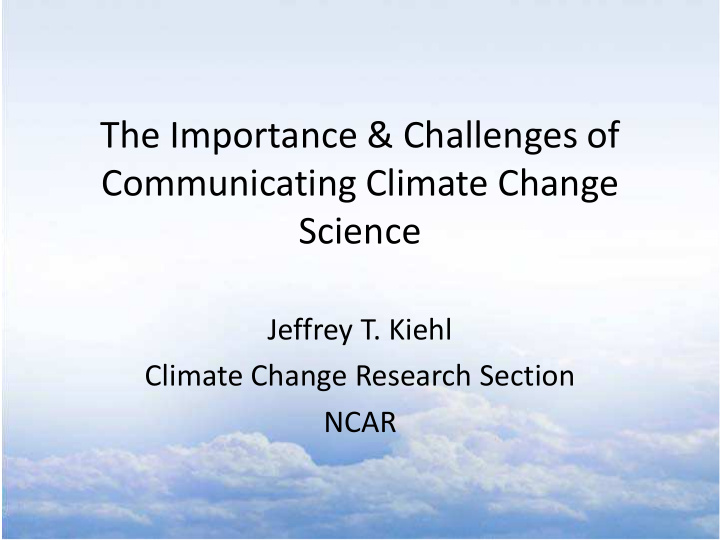



The Importance & Challenges of Communicating Climate Change Science Jeffrey T. Kiehl Climate Change Research Section NCAR
Outline • Why Climate Communication is Important • Barriers to Climate Communication • Breaking Through the Barriers in Communication • Summary
Why Climate Communication is Important
What’s the Problem? Yale Project on Climate Change Communication
Yale Project on Climate Change Communication
Public Perception of Scientific Consensus on Global Warming
Perception versus Fact http://www.wunderground.com
Perception versus Fact DAVOS 2015 http://www.wunderground.com
What the Past Tells Us
Barriers to Climate Communication
• Basic Understanding of Science • Social & Cultural Dimensions • Economic Dimensions • Psychological Dimensions
Basic Understanding of Science The Difference Between Weather & Climate NASA GISS
Social, Cultural & Economic Factors • Challenge to Value Systems, e.g. religious beliefs • Threat to Independent Agency, e.g. freedom • Threat to Meeting Basic Needs, e.g. economic stability • Threat to Privates Sectors, e.g. fossil fuel industry
{Religious systems, Beliefs Family systems, Personality structure} Values Awareness Information {Science, Education, Media,...} {Social Constructs, Social Political Systems, Norms Economic Systems}
Psychological Dimensions • Affect Response & Regulation • Self Identity & Consumption • Relatedness to Non - Human Environment • Typological Character Structures
Affect & Decision Making “ affect ... has rarely been recognized as an important component in human judgment and decision making. Perhaps befitting its rationalistic origins, the main focus of descriptive decision research has been cognitive, rather than affective ” Slovic et al. (2002)
Affective Reactions to News of Climate Change Numbness Defiance Fear Helplessness Guilt Anger Powerless All are Signatures of Trauma
Breaking Through the Barriers in Communication
A Three Stage Process Part I Part II Part III Science Narrative with Affective Metaphors & Images How Do You Feel? Explore Solutions
Connecting People to the Science • Construct narratives rich in images • Recognize the importance of felt sense of experience (e.g. ‘the bank account’) • Make the climate scientists real people • Use stories relating the history of discovery • Use Earth’s history as a means to connect to warm worlds • Convey that models are useful tools
Observations Images Public Narratives Awareness Metaphors Theory Models Value Systems Framing
Summary • Present the basic facts of Global Warming that are well understood • Recognize the psychological processes that act to modulate people’s reactions to disturbing information • Seek out images that most effectively convey the issue of global warming, images that are affect laden recognizing that these images are context specific ! • Leave the audience with a feeling of options and opportunities (e.g. "the wedges")
Recommend
More recommend